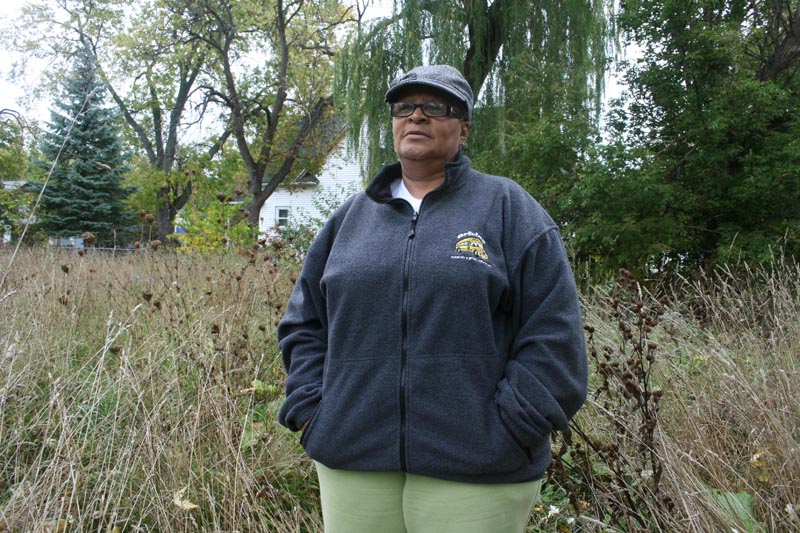City blues: MSU study finds state tax policies cripple cities
Michigan and California don't often land in the same sentence for economic comparison, but a new report concludes that both states share a dubious distinction: Their tax policies help cultivate financial crisis in their cities.
“We contend that they have structured local fiscal policymaking in a way that effectively incubates financial distress,” states a Michigan State University analysis.
While an improving Michigan economy is helping to boost local tax revenues, the report concludes that state policies also contribute to the likelihood that cities in Michigan will continue to face fiscal trouble. The problem, according to the report, is that Michigan tax policies restrict how much revenue cities can collect while, at the same time, placing more of a burden on local government to provide services.
“Michigan’s particular mix of stringent limitations on local revenue and its relatively low level of financial assistance to cities, coupled with spending pressures stemming from spiking local service burdens and increased labor costs, creates conditions that drive up the potential for local fiscal distress,” the report states.
The report, funded by the C.S. Mott Foundation, examined nearly a half-century of state and local financial data and weighed input from analysts, state officials and legal experts in concluding that Michigan, when compared with similar states, “provides a particularly difficult environment for its cities.”
The findings are not embraced by some in the state’s Republican-controlled leadership, who contend that local governments can in some instances do more to control costs while also noting a recent increase in tax revenue the state shares with municipalities.
MSU researchers say no one policy fix will solve the financial stress faced by cities; they instead recommend changes that will more readily align state policy priorities with what cities need to remain financially stable. That would include, the report suggests, a more collaborative environment between local and state leaders, what the report calls “a partnership and culture of trust.”
“For me, that's the bottom line here,” MSU economist Eric Scorsone, a co-author of the report, said of Michigan’s tax policies. “Why have we had so much fiscal distress? Yes, we have had a massive recession. But it is really beyond that story.”
Among the report's key findings:
Michigan is one of just eight states to impose three different tax limitations on local governments. Those limits include the Headlee Amendment, a measure approved by voters in 1978 that puts a strict cap on municipal tax revenues, and Proposal A, approved in 1994, which prevents the taxable value of property from rising as quickly as property values. State law also limits cities to a maximum tax rate of 20 mills, though city charters often set a lower limit.
Michigan is second only to Colorado in the increased severity of its tax restrictions from 1970 to 2005.
Michigan cities are also likely to incur higher labor costs than those in many other states, largely because many are heavily unionized. The report finds that states including Michigan, California and others, have public employee unionization rates in excess of 50 percent, while states such as North Carolina and Virginia have public employee unionization rates of about 10 percent. Union workers, in general, earn higher wages and better benefits than nonunion workers.
“To be clear, we do not suggest that a non-unionized workforce is the key to a fiscally sustainable city,” the report states; it is merely noting that the higher the labor costs in local budgeting, the tighter the budget constraints for cities.
Scorsone said the combination of high labor costs and restrictive state tax policy amounts “to the worst of both worlds” for Michigan cities.
Republican leadership in Lansing defended its record on municipal finance, noting for instance recent increases in revenue sharing for cities ‒ from just over $200 million in fiscal 2012 to nearly $250 million projected in fiscal 2016. A spokesman for GOP House Speaker Kevin Cotter suggested cities incurred some of the fiscal stress by agreeing to expensive retiree health care and pension benefits in better times.
Referring to that debt, the spokesman, Gideon D’Assandro, said, “There do appear to be some bad deals out there. Speaker Cotter and his fellow lawmakers put the taxpayers first when they first took office by cutting our own pay and benefits to make the budget work. We could see more of that from our local governments, too.”
Tax reform forerunners
But is it coincidence that Michigan is home to the first major U.S. city – Detroit – to declare bankruptcy? Or that California leads the nation in the number of municipal bankruptcies, with four of the 13 U.S. cities to have filed for bankruptcy by 2014?
Michigan and California were early adopters of the tax reform movement that picked up steam in 1970s, as taxpayers took their ire over escalating property tax bills to the polls.
California went first, as voters in June 1978 approved Proposition 13. Championed by anti-tax activist Howard Jarvis, it rolled back property assessments, froze them at 1976 levels and limited their increase to 2 percent a year. Just as critically, it prohibited state or local government from raising new taxes without a two-thirds vote of the governing body.
Michigan followed suit, as voters in November 1978 approved the Headlee Amendment, which limited state spending and capped local property tax millage rates to the rate of inflation.
Sixteen years later, Michigan voters approved Proposal A, a school funding reform measure that capped increases in the taxable value of property to 5 percent or the rate of inflation, whichever is less. That meant municipalities would suffer huge losses in property tax revenue when taxable values plunged – as they did in the Great Recession – but they could not reap full benefit from the economic rebound when increased values exceed 5 percent or the rate of inflation.
As Michigan's economy imploded, state and local governments levied $1.3 billion less in property taxes in 2011 than 2007 because of declining property values and exemptions from the tax, according to Treasury Department figures. Municipalities scrambled to balance their budgets, in many cases by neglecting parks, streets and laying off police and firefighters.
There is no consensus in California on the impact of Proposition 13. Advocates contend it reeled in excess spending while protecting taxpayers. And clearly, like Michigan, the fiscal stress in many of its cities is linked to a precipitous drop in property values that accompanied the Great Recession.
Nonetheless, critics say Proposition 13 has made things worse for cities, while gutting spending on public schools.
Indeed, in a 2012 analysis titled, “Why Some California Cities Are Choosing Bankruptcy,” Moody's Investment Service concluded: “The depressed housing market has also significantly affected property tax revenues, since Proposition 13, the state’s constitutional property tax limitation, restricts the ability of municipalities to adjust tax rates, thereby capping property tax revenues at a time when flexibility is most needed.”
A 2011 report by Bloomberg Business stated that California fell from seventh place before passage of Proposition 13 in K-12 spending per pupil among states to 27th place, according to the U.S. Census Bureau.
Anthony Minghine of the Michigan Municipal League, which has been critical of the state’s tax policies toward cities, particularly regarding revenue sharing, said the combination of Headlee and Proposal A is likewise choking off revenue streams for Michigan cities as they try to dig out of the recession.
“You have double limitations on that,” Minghine told Bridge.
Under Proposal A, municipal property tax revenue falls in lockstep with taxable value, so that if homes in a given community lose 20 percent of their value, the city's revenue drops by 20 percent as well. It doesn't work in reverse. With homes in places like Ann Arbor rising in value this year by nearly 10 percent, taxable value can only rise by 1.6 percent – the 2015 inflation rate as calculated by the State Tax Commission.
A little-known provision of Proposal A further crimps municipal finances, the MSU report notes. Under the Headlee Amendment, cities were required to roll back their authorized millage rate if taxable property value, excluding new construction, exceeded inflation. But they could “roll up” their millage rate the following year if the rise in taxable was less than inflation. Proposal A prohibits such roll-ups.
“You only have a gate that swings one way. We have a broken municipal finance model,” Minghine said.
State priorities
Michigan's municipal fiscal plight has also been aggravated by political choices, as state legislators for more than a decade have chosen to balance the budget on the backs of municipalities, according to Minghine. In a 2014 analysis, Minghine noted that projected statutory municipal revenue sharing had been cut by more than $6 billion from 2003 to 2014, falling from about $900 million a year to about $250 million. Municipalities rely on revenue sharing for everything from police and fire to roads and park maintenance.
“What's most shocking is the difference those revenue sharing dollars would have made at the local level,” Minghine’s analysis stated.
The Municipal League’s analysis found that more than $700 million in projected revenue sharing had been taken from Detroit during that time, more than $70 million from Grand Rapids, $55 million from Flint, more than $40 million from Pontiac and $31 million from Dearborn. Hamtramck, which came out of emergency management in December 2014, lost $13 million.
“We now have a record number of communities facing financial emergencies. It’s easy to blame local leaders, but you must consider all the facts. In most cases, communities that currently face large deficits would in contrast have general fund surpluses,” the MML analysis stated.
D’Assandro, the Cotter spokesman, preferred to focus on the recent gains in revenue sharing, saying Cotter is proud of the legislature's votes to increase revenue sharing “again and again in recent years.”
According to a Michigan Department of Treasury document, statutory revenue sharing funds for cities, villages and townships has increased from $209 million for fiscal 2012 to $248 million projected for fiscal 2016. But that’s still far below the amount allocated more than a decade ago.
Crushing legacy benefits
Michigan cities also continue to face the crushing weight of legacy pension and retiree health care obligations incurred during better economic times.
A 2013 MSU report co-authored by Scorsone concluded that unfunded legacy debt in Michigan cities, excluding Detroit, exceeded $10 billion in 2011. Nearly 80 percent of this debt was tied to retiree health care, Bridge reporting showed.
It found that legacy debt was equal to 30 percent of general revenue brought in each year by Ann Arbor, 25 percent in Grand Rapids, 38 percent in Lansing and 85 percent in Saginaw. The analysis cites 311 cities, villages and townships in Michigan that provided some kind of retirement health care benefits at the end of fiscal 2011, with a total liability of $13.5 billion. Just 6 percent of that was funded, leaving a net unfunded liability of $12.7 billion.
To be sure, auto-dependent industrial cities like Flint, Saginaw and Detroit have also been slammed by cascading losses in population over several decades. Detroit, with a high of 1.8 million residents in 1950, now has fewer than 700,000 residents. Saginaw's population fell from more than 90,000 in 1970 to barely 50,000 today. Flint's population is now just under 100,000, from more than 190,000 in 1970.
Given this constellation of factors, maybe it should come as no surprise that 13 municipalities in Michigan are in some stage of emergency management, receivership or transition under the emergency management act of 2012. Seven, including Detroit, are in Wayne County.
“It's not just the basket cases,” Scorsone said. “It's other cities as well.”
City of Lansing’s decline
Lansing is a typical example. As property values and state revenue sharing dropped, it had no choice but to slash payroll and cut costs where it could. From 2006 to 2013, the city cut its work force by 30 percent, from 1,220 to 852. It negotiated increases in employee health care premiums and pension contributions. It closed three fire stations and reduced minimum staffing requirements for firefighters. It closed two municipal golf courses.
Roads suffered. From 2004 to 2013, the percentage of federally funded roads in that city that were in poor condition soared from 4 percent to 40 percent.
In November 2011, voters approved a 5-year, 4-mill tax increase to fund the police and fire departments – avoiding threatened cuts of 120 employees in the police and fire departments. They turned down the same request six months earlier.
Lansing Mayor Virg Bernero said municipalities are doing the best they can with limited resources. But he said there's a limit to how deep cities can cut. Its current general fund budget of $120 million, adjusted for inflation, is less than the city's 1999 budget, he said.
“There is a reason that our cities look the way they do. We are in a financial pressure cooker,” Bernero told Bridge. “How is the state going to grow when our cities are on life support? Our urban policy today is a prescription for failure.”
Bernero, a Democrat who was defeated by GOP Gov. Rick Snyder in the 2010 race for governor, said the Republican-controlled state Legislature is “somewhere between oblivious and callous about the needs of city government.”
Saginaw’s struggles
Saginaw, on the high side of fiscal stress, has managed to avoid emergency management. But the city is barely recognizable from what it was decades ago.
According to the Municipal League, it lost more than $30 million in projected revenue sharing from 2003 to 2014. A 2013 report by Michigan State University on municipal legacy debt found that Saginaw’s unfunded retiree health care debt in 2011 was about $200 million. It had more than $100 million in unfunded pension debt and spent more than $8 million – a fourth of the general fund budget - on retiree health care in 2013, leaving much less to pay for basic services for residents.
That includes police and fire, normally the last services a municipality cuts. The city has slashed its police force to 55, a quarter of its staffing level in 1975 - and a cut twice as steep as the drop in population during that time. Its fire department is staffed at 50, half what it was in 1995.
Its streets have steadily deteriorated, with 57 percent of its federal aid roads in poor condition in 2013.
The same year, city officials decided to stop cutting weeds in the hundreds of vacant parcels scattered around town – a measure to save $200,000 a year. The resulting weed-choked lots left many residents complaining the city no longer cared about their neighborhoods. The Saginaw Land Bank in 2014 agreed to pay the city $45,000 to cut some of the lots while the city mulls a long-term solution.
East side Saginaw homeowner Madeleine O'Neal has watched the neighborhood in which she has lived for 20 years slide into something of an urban wasteland. Weedy, vacant lots now outnumber the homes on her street.
She said she has called the city to complain, to ask that someone come out and mow the empty lots, to no avail.
“They say they don't have the funds. But they don't really care about our side of town. It's a shame the city doesn't do anything.
“If I had some money, I'd be gone.”
Minghine of the Michigan Municipal League said there comes a point where steep budget cuts only accelerate a city's decline. Property tax is a key revenue source, but one that hinges on the perceived value of property. Homes sitting next to weedy vacant lots are not likely to appreciate in value.
“The value is a function of the desirability of the community I live in. What I am doing (with severe budget cuts) is make that community much less desirable. It becomes a death spiral.
“Our goal should be places where people want to live.”
Closing city-state divide
The MSU report on Michigan's tax policies and municipal funding stops short of proposing dramatic change to the system, a frank nod to the political barriers to any major tax overhaul that would give a significant bump in funding for cities. The report archly notes that state “policymakers tend to focus more on short-term political gain rather than the histories and unintended consequences of policies that, over time, become increasingly difficult to alter.”
“It would be impractical to recommend major policy overhauls of Proposal A, the Headlee Amendment, collective bargaining rules and state revenue sharing,” it stated.
Amber McCann, spokesperson for Senate Majority Leader Arlan Meekhof, R-Ottawa County, confirmed as much, stating: “The Majority Leader has not considered undoing Headlee or Proposal A.”
She added, however, that he is “open to a discussion” about revenue sharing.
The report did recommend creation of a state agency to coordinate services to local government, offer technical support and fiscal monitoring and “help create a partnership and culture of trust between the state and its municipalities.”
It also said Michigan could learn something from Pennsylvania, whose Act 47 allows the state to place fiscally distressed communities in receivership, with an oversight board “that acts as a liaison between the local government and others to improve the financial integrity of the city and is typically able to broker additional state funding for the distressed community.”
Minghine, as well, acknowledges how difficult it will be to make fundamental change to Michigan’s municipal finance system.
“We're not naïve about the difficulties of doing that. Will we get to the Pollyanna place that's perfect? Not in my lifetime,” he said.
But he cautions that acceptance of the status quo in municipal finance is not a good long-term prescription for Michigan's cities. He noted what’s at stake, given a recent report by the Municipal League that metropolitan areas in Michigan account for 89 percent of the state’s jobs and 88 percent of its gross domestic product.
“Cities are the economic engine of Michigan. We need a fresh look at our finance system. We need a model that will allow locals to share in a prosperous economy.”
See what new members are saying about why they donated to Bridge Michigan:
- “In order for this information to be accurate and unbiased it must be underwritten by its readers, not by special interests.” - Larry S.
- “Not many other media sources report on the topics Bridge does.” - Susan B.
- “Your journalism is outstanding and rare these days.” - Mark S.
If you want to ensure the future of nonpartisan, nonprofit Michigan journalism, please become a member today. You, too, will be asked why you donated and maybe we'll feature your quote next time!


 Saginaw homeowner Madeleine O'Neal, standing in a weedy lot near her home, said she believes the city has abandoned her neighborhood. (Bridge photo by Ted Roelofs)
Saginaw homeowner Madeleine O'Neal, standing in a weedy lot near her home, said she believes the city has abandoned her neighborhood. (Bridge photo by Ted Roelofs) Michigan State University economist Eric Scorsone: “Why have we had so much fiscal distress? Yes, we have had a massive recession. But it is really beyond that story.” (Courtesy photo)
Michigan State University economist Eric Scorsone: “Why have we had so much fiscal distress? Yes, we have had a massive recession. But it is really beyond that story.” (Courtesy photo) Anthony Minghine of the Michigan Municipal League: “We have a broken municipal finance model.” (Courtesy photo)
Anthony Minghine of the Michigan Municipal League: “We have a broken municipal finance model.” (Courtesy photo) Lansing Mayor Virg Bernero: The GOP-controlled Legislature is “somewhere between oblivious and callous about the needs of city government.”
Lansing Mayor Virg Bernero: The GOP-controlled Legislature is “somewhere between oblivious and callous about the needs of city government.”